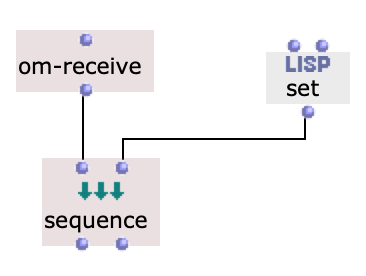Dear community,
I hope you are all well.
I have created a series of sub-patches that should allow me to to control different stages of processes and/or its parameters. I know that, if a sub-patch has inputs, it can’t be evaluated inside itself. (If I open a sub-patch (that has inputs) any change inside the sub-patch will be calculated only at its output, but the changes will not be displayed in OM-class-objects inside a sub-patch.) In order to solve this problem I am using some kind of “remote messaging” by sending the incoming value(s) to the sub-patch via lisp functions set-value -> eval, what enables me to view and edit om-class-objects inside a sub-patch. Yet, this way is very annoying for the workflow, since I have to evaluate manually set-function each time the incoming value changes. (Sometimes there is a series of sub-patches controlling different parameters of the same process, what requires a lot of manual evaluations and so enhances the possibility of false inputs to calculations.)
Although I am aware that OM (since being based on Lisp) is not a data-flow working program, still I am wondering is there a better solution that would enable automatic reset of set-function by each change of the incoming value, or perhaps a completely different solution to this problem (enable inside evaluation of certain sub-patches, creating new classes instead of creating a control sub-patches, or…?).
In order to make my question(s) more clear, I am sending an example patch:
controling patch example.omp (460.3 KB)
So the questions are:
- Is it yet somehow possible to edit and view class objects inside s sub-patch with inputs?
- Is it possible to automatically trigger the evaluation of the set-function by each change of the incoming value (for the purpose of automatizing the “remote messaging”)?
- Is there a better way to create control surfaces using class-objects?
I would appreciate answers and ideas!
All the best!
Aliser

